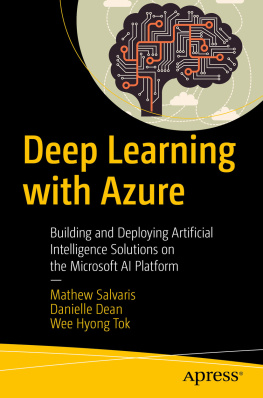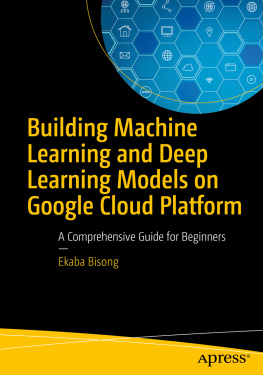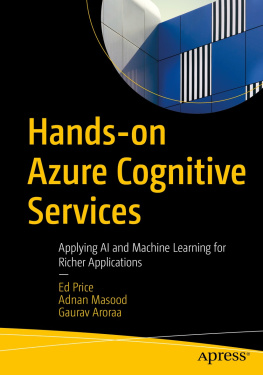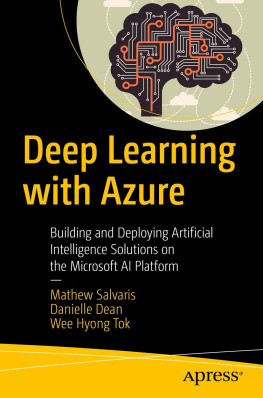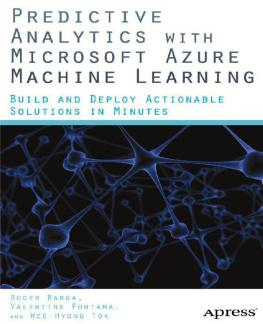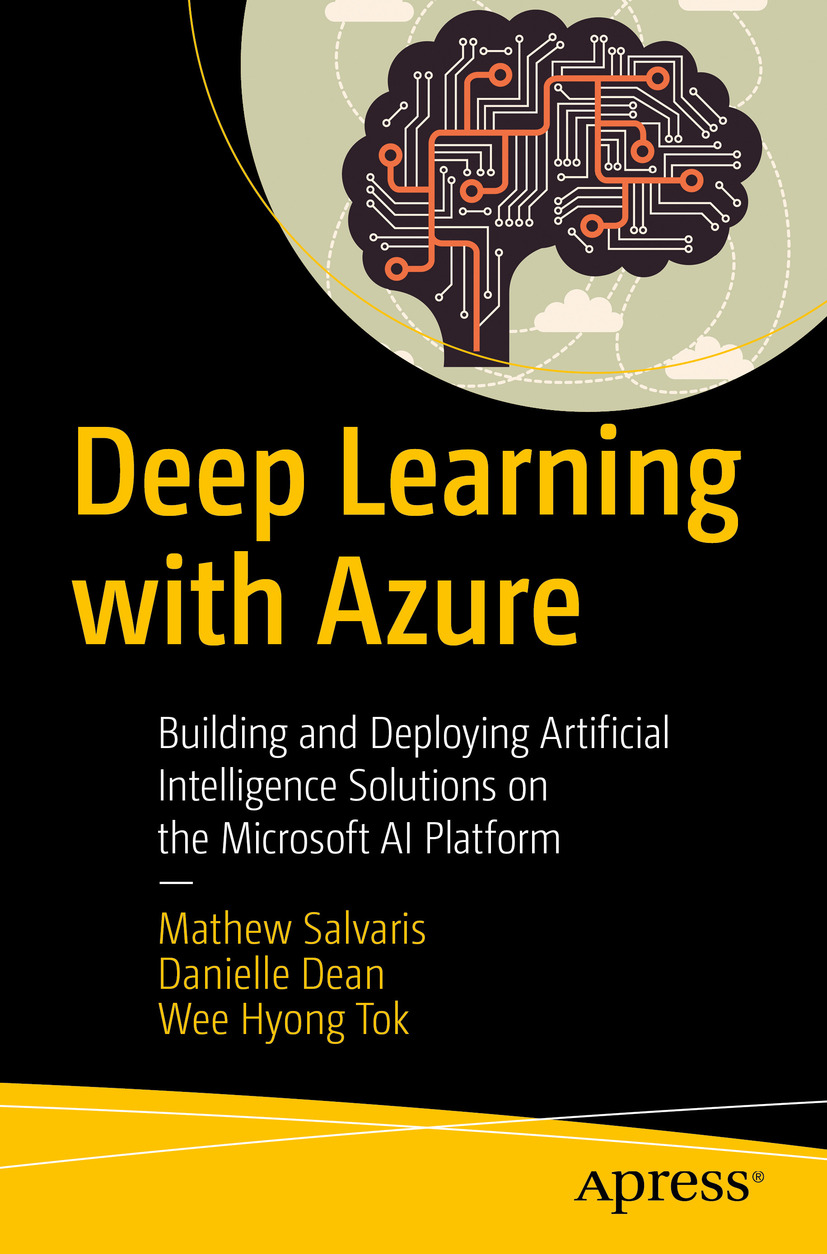Mathew Salvaris , Danielle Dean and Wee Hyong Tok
Deep Learning with Azure Building and Deploying Artificial Intelligence Solutions on the Microsoft AI Platform
Mathew Salvaris
London, UK
Danielle Dean
Westford, Massachusetts, USA
Wee Hyong Tok
Redmond, Washington, USA
Any source code or other supplementary material referenced by the author in this book is available to readers on GitHub via the book's product page, located at www.apress.com/9781484236789 . For more detailed information, please visit http://www.apress.com/source-code .
ISBN 978-1-4842-3678-9 e-ISBN 978-1-4842-3679-6
https://doi.org/10.1007/978-1-4842-3679-6
Library of Congress Control Number: 2018953705
Mathew Salvaris, Danielle Dean, Wee Hyong Tok 2018
This work is subject to copyright. All rights are reserved by the Publisher, whether the whole or part of the material is concerned, specifically the rights of translation, reprinting, reuse of illustrations, recitation, broadcasting, reproduction on microfilms or in any other physical way, and transmission or information storage and retrieval, electronic adaptation, computer software, or by similar or dissimilar methodology now known or hereafter developed.
Trademarked names, logos, and images may appear in this book. Rather than use a trademark symbol with every occurrence of a trademarked name, logo, or image we use the names, logos, and images only in an editorial fashion and to the benefit of the trademark owner, with no intention of infringement of the trademark. The use in this publication of trade names, trademarks, service marks, and similar terms, even if they are not identified as such, is not to be taken as an expression of opinion as to whether or not they are subject to proprietary rights.
While the advice and information in this book are believed to be true and accurate at the date of publication, neither the authors nor the editors nor the publisher can accept any legal responsibility for any errors or omissions that may be made. The publisher makes no warranty, express or implied, with respect to the material contained herein.
Distributed to the book trade worldwide by Springer Science+Business Media New York, 233 Spring Street, 6th Floor, New York, NY 10013. Phone 1-800-SPRINGER, fax (201) 348-4505, e-mail orders-ny@springer-sbm.com, or visit www.springeronline.com. Apress Media, LLC is a California LLC and the sole member (owner) is Springer Science + Business Media Finance Inc (SSBM Finance Inc). SSBM Finance Inc is a Delaware corporation.
Dedicated to our families and friends who supported us as we took away from our personal time to learn, develop, and write materials for this book.
Special dedication to Juliet, Nathaniel, Jayden, and Adrian
Foreword
Artificial intelligence (AI) at its core is about empowering people and organizations to reason and interact with the increasingly digital world all around us. Whether it be in health care or in financial services or in government, AI is helping transform customer experiences, business models, and operational efficiencies in a dramatic way. In this book, Mathew, Danielle, and Wee Hyong present a practical overview of why the impact of AI and deep learning has accelerated recently and illustrate how to build these solutions on the Microsoft Cloud AI platform. They build on their experiences as leading data scientists at Microsoft working both with the product group as well as with external customers. In this book you will see a fresh perspective on how to approach building AI solutions: from the common types of models to training and deployment considerations for end-to-end systems.
This topic is very near to my heart. As a Corporate Vice President and CTO of Artifical Intelligence at Microsoft, I have had the privilege of leading the development of many of our AI products mentioned in this book. Take Unilever, for example: They have built a collection of chat bots with a master bot to help their employees interact with human resources services and all services inside the enterprise. Jabil uses AI for quality control in the circuit board manufacturing process. Cochrane uses AI to classify medical documents and organize information for systematic reviews. Publicis used AI to build an app for makeup recommendations. eSmart Systems has a connected drone with deep learning-based defect detection for inspecting power lines in the energy sector. AI is even being used to identify and conserve snow leopards in the Himalayas. AI is becoming the new normal.
Contrast these examples to enterprise IT systems of the past. We first developed systems of record for enterprises to operate. We had enterprise resource planning (ERP) systems. We had customer resource management (CRM) systems. Most of these were rather siloed and served specific individual functions, with highly structured and curated data. Then the Web came along, and the Internet came along, and we built systems to interact with our customers over the Web. We started building Software as a Service (SaaS) applications hosted in the cloud.
Now what we have at our disposal thanks to the type of technologies and techniques mentioned in this book are systems of intelligence in the cloud . A system of intelligence integrates data across all those systems of record, connects you to the systems of engagement, and creates a connected enterprise that understands, reasons, and interacts in a very natural way. Built as a collection of interoperating SaaS applications, these systems collect and organize all relevant data and interactions in the cloud. They constantly learn using AI and deliver new experiences. Live online experiments constantly explore a space of possibilities to teach and derive new AI capabilities. All this is done with the power of the cloud.
When you are building powerful systems like this, you need a very comprehensive platform. Its not just one or two components, or a few components from open source integrated with existing enterprise applications. You cant just take a deep learning tool, learn with a little bit of data, put the model in a virtual machine on the cloud, and build a system of intelligence. You need a comprehensive collection of platform services that only a cloud platform can bring, including systems for identity and security. This is the differentiation of the Microsoft AI platform. It is cloud-powered AI for next-generation systems of intelligence.
I am a big believer in democratizing AI for developers. A lot of AI itself should be almost as simple as calling a sort function. You just call a sort function, and you get an output. The Microsoft AI platform provides a wealth of prebuilt AI like speech recognition, translation, image understanding, optical character recognition (OCR), and handwriting recognition, many of which are built on top of advanced deep learning technology explained in this book. Many of these prebuilt AI capabilities can be fine-tuned with your own data. Developers can use such prebuilt AI to understand the content of every type of media and information videos, images, natural handwritingand organize and reason with it. For the use cases where prebuilt AI can solve the problem, these services dramatically increase developer productivity and time to market.

